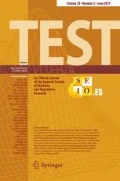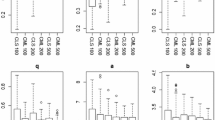Abstract
We define a new multivariate time series model by generalizing the ARMAX process in a multivariate way. We give conditions on stationarity and analyze local dependence and domains of attraction. As a consequence of the obtained results, we derive new multivariate extreme value distributions. We characterize the extremal dependence by computing the multivariate extremal index and bivariate upper tail dependence coefficients. An estimation procedure for the multivariate extremal index is presented. We also address the marginal estimation and propose a new estimator for the ARMAX autoregressive parameter.



Similar content being viewed by others
References
Alpuim MT (1989) An extremal Markovian sequence. J Appl Probab 26:219–232
Billingsley P (1995) Probability and measure, 3rd edn. Wiley, New York
Canto e Castro L (1992) Sobre a Teoria Assintótica de Extremos. PhD Thesis, FCUL 1992
Daley D, Haslett J (1982) A thermal energy storage with controlled input. Adv Appl Probab 14(2):257–271
Davis R, Resnick S (1989) Basic properties and prediction of max-ARMA processes. Adv Appl Probab 21:781–803
Einmahl JHJ, Krajina A, Segers J (2012) An M-estimator for tail dependence in arbitrary dimensions. Ann Stat 40(3):1764–1793
Ferreira H (1994) Multivariate extreme values in T-periodic random sequences under mild oscillation restrictions. Stoch Process Appl 49:111–125
Ferreira M (2012) Parameter estimation and dependence characterization of the MAR(1) process. ProbStat Forum 5(12):107–111
Ferreira M, Canto e Castro L (2008) Tail and dependence behaviour of levels that persist for a fixed period of time. Extremes 11(2):113–133
Ferreira M, Canto e Castro L (2010) Modeling rare events through a pRARMAX process. J Stat Plan Inference 140(11):3552–3566
Ferreira H, Ferreira M (2012) On extremal dependence of block vectors. Kybernetika 48(5):988–1006
Greenwood PE, Hooghiemstra G (1988) An extreme-type limit law for a storage process. Math Oper Res 13(2):232–242
Haslett J (1979) Problems in the stochastic storage of a solar thermal energy. In: Jacobs O (ed) Analysis and optimization of stochastic systems. Academic Press, London
Heffernan JE, Tawn JA, Zhang Z (2007) Asymptotically (in)dependent multivariate maxima of moving maxima processes. Extremes 10:57–82
Huang X (1992) Statistics of bivariate extreme values. Thesis Publishers, Amsterdam
Joe H (1997) Multivariate models and dependence concepts. Chapman & Hall, London
Leadbetter MR, Nandagopalan S (1989) On exceedance point processes for stationary sequences under mild oscillation restrictions. In: Hüsler J, Reiss R-D (eds) Extreme value theory. Springer, Berlin, pp 69–80
Leadbetter MR, Lindgren G, Rootzén H (1983) Extremes and related properties of random sequences and processes. Springer, New York
Lebedev AV (2008) Statistical analysis of first-order MARMA processes. Math Notes 83(4):506–511
Ledford A, Tawn JA (1996) Statistics for near independence in multivariate extreme values. Biometrika 83:169–187
Ledford A, Tawn JA (1997) Modelling dependence within joint tail regions. J R Stat Soc, Ser B, Stat Methodol 59:475–499
Nandagopalan S (1990) Multivariate extremes and estimation of the extremal index. PhD Dissertation, Department of Statistics, University of North, Carolina, USA
Prokhorov YV (1956) Convergence of random processes and limit theorems in probability theory. Theory Probab Appl 1(2):157–214
Schmidt R, Stadtmüller U (2006) Nonparametric estimation of tail dependence. Scand J Stat 33:307–335
Sibuya M (1960) Bivariate extreme statistics. Ann Inst Stat Math 11:195–210
Smith RL, Weissman I (1996) Characterization and estimation of the multivariate extremal index. Technical Report, Univ North, Carolina
Stout W (1974) Almost sure convergence. Academic Press, New York
Zhang Z (2006) A new class of tail-dependent time-series models and its applications in financial time series. In: Fomby TB, Terrell D (eds) Econometric analysis of financial and economic time series. Advances in econometrics, vol 20. Emerald Group Publishing Limited, Bingley, pp 317–352
Zhang Z (2008) The estimation of M4 processes with geometric moving patterns. Ann Inst Stat Math 60:121–150
Acknowledgements
We are very grateful to the referees for their valuable corrections and suggestions. Helena Ferreira was partially supported by the research unit “Centro de Matemática” of the University of Beira Interior and the research project PTDC/MAT/108575/2008 through the Foundation for Science and Technology (FCT) co-financed by FEDER/COMPETE. Marta Ferreira was financed by FEDER Funds through “Programa Operacional Factores de Competitividade—COMPETE” and by Portuguese Funds through FCT—“Fundação para a Ciência e a Tecnologia”, within the Project Est-C/MAT/UI0013/2011.
Author information
Authors and Affiliations
Corresponding author
Rights and permissions
About this article
Cite this article
Ferreira, M., Ferreira, H. Extremes of multivariate ARMAX processes. TEST 22, 606–627 (2013). https://doi.org/10.1007/s11749-013-0326-6
Received:
Accepted:
Published:
Issue Date:
DOI: https://doi.org/10.1007/s11749-013-0326-6
Keywords
- Multivariate extreme value theory
- Maximum autoregressive processes
- Multivariate extremal index
- Tail dependence
- Asymptotic independence




